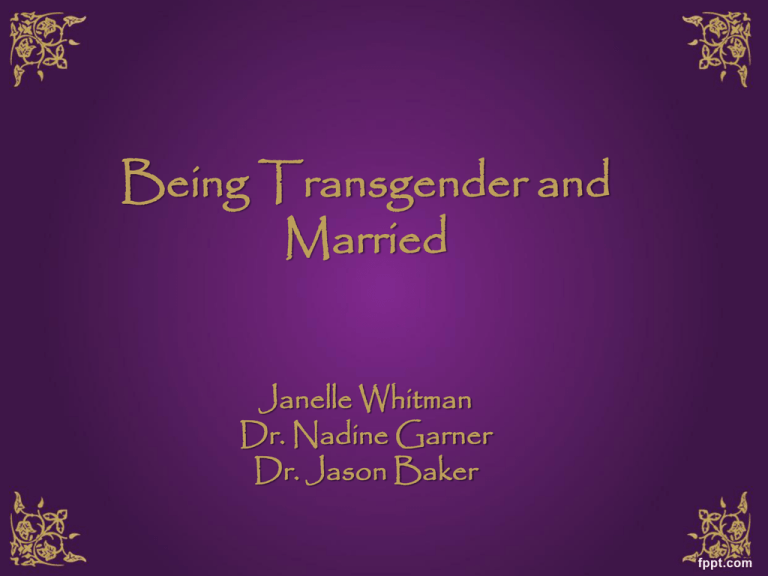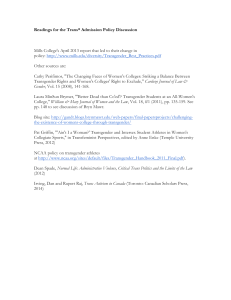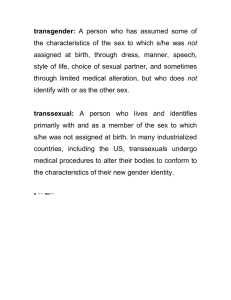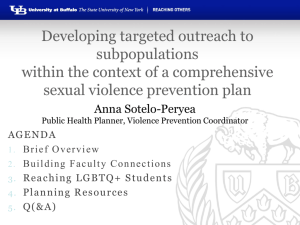
Being Transgender and
Married
Janelle Whitman
Dr. Nadine Garner
Dr. Jason Baker
Communication
Honesty
Trust
Respect
Research
Positive Plans to Move Forward:
Emerging Research, Injustice Issues
• Grant et al. (2011)
•
Surveyed 6,450 transgender and gender non-conforming participants, 50
states +
• Extreme poverty - nearly four times more likely to have a household
income of less than $10,000/year compared to the general population.
• 41% of respondents reported attempting suicide compared to 1.6% of
the general population
• K-12 reported alarming rates of harassment (78%), physical assault
(35%) and sexual violence (12%); harassment was so severe that it
led almost one-sixth (15%) to leave a school in K-12 settings or in
higher education
• Blumer et al. (2012)
•
•
Initial focus of counseling and psychological interventions alleviating
discomfort and incongruence
Focus increasingly on addressing relational, family and communication
issues to address optimal functioning of transperson
Research
Positive Plans to Move Forward:
Communication Issues
• Bischof et al. (2011)
It is important for both partners to recognize that transitioning in a
relationship is a shared journey.
•
Partners need to explore the impact on 3 dimensions:
1) Intrapersonal – how both partners personally think and feel
about the transition.
SO’s have strong reactions to their partner’s disclosure/discovery; SO’s
question their own self-esteem, and sexual orientation.
2) Couple Relationship – how disclosure/discovery is handled,
how sexual relationship is impacted, how the process of transitioning unfolds,
how the relationship is renegotiated and how boundaries are set.
3) Family and Social Relationships – how sources of support and coping are
cultivated, how relationships with immediate and extended family members are
established, and how disclosures to others (friends, coworkers, supervisors)
are made.
Research
Positive Plans to Move Forward:
Injured Attachment
• Chapman & Caldwell (2012)
•
•
•
•
to describe any incident where an individual’s partner is perceived to be
inaccessible or unresponsive in a critical moment, especially when
attachment needs are particularly salient. This is significant because it
results in a tear in the fabric of, or disconnection in, the attachment bond
creating negative interactional cycles that perpetuate relational distress
(Johnson et.al., 2001, p. 56).
Focus on TI (transidentification process) as visible and public remaking of
oneself physically and socially
Attachment injury is real-time and ongoing
TI partner provides source of and resolution of attachment pain
• Lev (2005)
•
Life-cycle transition theory of TI
• Discovery/Disclosure – marital tension, shock/betrayal
• Turmoil – shutting down/exploding in anger, conflict heightened
• Negotiation – family begins to cope and process, level of change
allowable, boundaries, etc.
• Balance/Acceptance – family ready to integrate TI partner back into
family system
Research
Positive Plans to Move Forward:
How do you make new meanings? (Norwood, 2012)
Partners need to acknowledge the struggle to make new meanings:
• Presence vs. Absence:
The trans person is not “dead” but has “transitioned”
• Sameness vs. Difference:
How same or different is the transgender person throughout
the transition process?
How same or different is the relationship between a
transgender person and his or her partner?
• Self vs. Other:
How does a SO support the trans partner when the SO is
struggling with a lack of understanding, religious or moral
beliefs, or their own emotional issues?
How does the trans person support others in coming to terms
with their identities and transitions, but focus on themselves
as well?
Millersville University Center for
Sustainability
Facebook Page:
Center for Sustainability –
Millersville University
References
Bischof, G. H., Warnaar, B. L., Barajas, M. S., & Dhaliwal, H. K. (2011). Thematic analysis of the experiences of wives who stay with
husbands who transition male-to-female. Michigan Family Review, 15(1), 16-34.
Blumer, M. L. C., Green, M. S., Knowles, S. J., & Williams, A. (2012, June). Shedding light on thirteen years of darkness: Content analysis
of articles pertaining to transgender issues in marriage/couple and family therapy journals. Journal of Marital and Family Therapy, 38(1),
244-256.
Buxton, A. P. (2006). When a spouse comes out: Impact on the heterosexual partner. Sexual Addiction & Compulsivity, 31, 317-332.
Chapman, D. M., Caldwell, B. E. (2012). Attachment injury resolution in couples when one partner is trans-identified. Journal of Systemic
Therapies, 31(2), 36-53.
Giammattei, Shawn V. (2015). Beyond the binary: Trans-negotiations in couple and family therapy. Family Process, 54(3),-418-434.
Grant, J. M., Mottet, L. A., Tanis, J., Harrison, J., Herman, J. L., & Keisling, M. (2011). Injustice at every turn: A report of the national
transgender discrimination survey. Washington, DC: National Center for Transgender Equality and National Gay and Lesbian Task Force.
Kins, E., Hoebeke, P., Heylens, G., Rubens, R., & De Cuypere, G. (2008). The female-to-male transsexual and his female partner versus
the traditional couple: A comparison. Journal of Sex & Marital Therapy, 34, 429-438.
Lev, A. I. (2005). Transgender emergence: A family affair. Division 44 Newsletter, 21(3), 11–12.
Norwood, K. M. (2010). Here and gone: Competing discourses in the communication of families with a transgender member.
Norwood, K. (2012). Transitioning meaning? Family members’ communicative struggles surrounding transgender identity. Journal of
Family Communication, 12, 75-92.
Samons, S. L. (2009). Can this marriage be saved? Addressing male-to-female transgender issues in couples therapy. Sexual and
Relationship Therapy, 24(2), 152-162.





